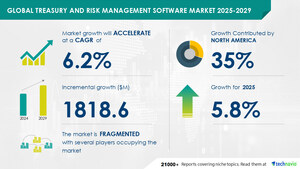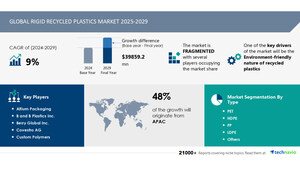NEW YORK, Nov. 12, 2024 /PRNewswire/ -- Report on how AI is redefining market landscape - The global industrial lubricants market size is estimated to grow by USD 15.55 billion from 2024-2028, according to Technavio. The market is estimated to grow at a CAGR of 4.44% during the forecast period. Increasing demand from end-user industries is driving market growth, with a trend towards strategic alliances related to industrial lubricants. However, fluctuations in crude oil prices poses a challenge.Key market players include AMSOIL Inc., Bharat Petroleum Corp. Ltd., BP Plc, Buhmwoo chemical Co. Ltd., Castrol Ltd., Chevron Corp., ENEOS Holdings Inc., Exxon Mobil Corp., FUCHS PETROLUB SE, Idemitsu Kosan Co. Ltd., Indian Oil Corp. Ltd., PetroChina Co. Ltd., Petroleo Brasileiro SA, Phillips 66, PJSC LUKOIL, Quaker Chemical Corp., Shell plc, TotalEnergies SE, Valvoline Inc., and Zeller and Gmelin GmbH and Co. KG..
AI-Powered Market Evolution Insights. Our comprehensive market report ready with the latest trends, growth opportunities, and strategic analysis- View Free Sample Report PDF
Forecast period |
2024-2028 |
Base Year |
2023 |
Historic Data |
2017 - 2021 |
Segment Covered |
Product (Mineral oil lubricants, Synthetic lubricants, and Bio-based lubricants), Type (Hydraulic fluid, Metal working fluid, and Others), and Geography (APAC, Europe, North America, Middle East and Africa, and South America) |
Region Covered |
APAC, Europe, North America, Middle East and Africa, and South America |
Key companies profiled |
AMSOIL Inc., Bharat Petroleum Corp. Ltd., BP Plc, Buhmwoo chemical Co. Ltd., Castrol Ltd., Chevron Corp., ENEOS Holdings Inc., Exxon Mobil Corp., FUCHS PETROLUB SE, Idemitsu Kosan Co. Ltd., Indian Oil Corp. Ltd., PetroChina Co. Ltd., Petroleo Brasileiro SA, Phillips 66, PJSC LUKOIL, Quaker Chemical Corp., Shell plc, TotalEnergies SE, Valvoline Inc., and Zeller and Gmelin GmbH and Co. KG. |
Key Market Trends Fueling Growth
Industrial lubricants play a crucial role in various industries, including hydraulics, compressors, centrifuges, industrial engines, bearings, and more. The base oil segment dominates the market, with trends leaning towards synthetic and bio-based options. Hydraulic fluids, metalworking fluids, and gear oils are in high demand. The unconventional energy industry is a growing niche sector for industrial lubricants, particularly in hydraulics and renewable generation. In metalworking applications, AI, automation processes, and robotic processing drive the need for advanced lubricants. Anti-foaming agents are essential additives for various industries like packaging, food oils, and crop protection oils. The fertilizer production sector relies on lubricants for equipment operation and pesticide carrier fluids. Classification of industrial lubricants includes mineral oil, synthetic oil, and bio-based oil. Developments in the energy sector, such as renewable generation, drive the demand for specialized lubricants. Market trends include the use of AI and automation in lubricant laboratory testing and analysis. The future of industrial lubricants lies in meeting the unique demands of various industries while ensuring sustainability and efficiency.
The industrial lubricants market is characterized by strategic collaborations and acquisitions among manufacturers. To ensure a consistent supply of raw materials, lubricant producers form partnerships with suppliers. Additionally, they team up with distributors to expand their market reach. Through acquisitions, companies broaden their product offerings and enhance operational capabilities. For instance, FUCHS and BASF's collaboration on Life Cycle Analysis of Hydraulic Fluids focuses on creating more sustainable lubricant products. Similarly, Total's acquisition of Tullow's interests in the Uganda Lake Albert development project expands its oil pipeline holdings. These alliances and acquisitions enable industrial lubricant manufacturers to strengthen their market position and innovate for a more sustainable future.
Insights on how AI is driving innovation, efficiency, and market growth- Request Sample!
Market Challenges
- The industrial lubricants market faces various challenges in sectors like base oils for hydraulic fluids, metalworking fluids, and lubricant laboratories. The unconventional energy industry requires specialized lubricants for hydraulics, compressors, centrifuges, and industrial engines. Bearings in packaging industries need high-performance lubricants. In the food industry, anti-foaming agents and vegetable preparation oils are essential. AI, automation processes, and robotic processing demand advanced lubricants. Niche sectors like renewable generation, metalworking applications, and metal products require specific lubricants. Classification and development drift pose challenges. Unconventional sectors like pesticide carrier fluids, fertilizers, and fertilizer production in the energy sector also need industrial lubricants. Gear oils are crucial in renewable generation.
- Industrial lubricants are primarily derived from crude oil through the process of fractioning. The global industrial lubricants market is dominated by mineral oil-based products. The oil and gas sector serves as a significant supplier of the raw materials required for lubricant manufacturing. However, the cost of industrial lubricants can be influenced by fluctuations in global crude oil prices. In 2021, crude oil prices experienced an increase due to the accelerated COVID-19 vaccination rollout, easing of restrictions, and economic recovery. This led to a faster demand for petroleum than its supply, ultimately impacting the price of raw materials and industrial lubricants.
Insights into how AI is reshaping industries and driving growth- Download a Sample Report
Segment Overview
This industrial lubricants market report extensively covers market segmentation by
- Product
- 1.1 Mineral oil lubricants
- 1.2 Synthetic lubricants
- 1.3 Bio-based lubricants
- Type
- 2.1 Hydraulic fluid
- 2.2 Metal working fluid
- 2.3 Others
- Geography
- 3.1 APAC
- 3.2 Europe
- 3.3 North America
- 3.4 Middle East and Africa
- 3.5 South America
1.1 Mineral oil lubricants- Mineral oil lubricants, derived from refined petroleum, are the most commonly used lubricants in various industries. These oils, primarily composed of hydrocarbons, offer a wide range of viscosities, effectively reducing friction and wear between moving parts. They are temperature stable, making them suitable for diverse operational conditions, and cost-effective, making them a preferred choice for numerous applications. In industrial machinery, mineral oil lubricants find use in pumps, compressors, and hydraulic systems. Additionally, they benefit metalworking processes and some household products. For enhanced performance, additives are incorporated to improve properties like oxidation resistance, corrosion protection, and anti-wear capabilities. Although mineral oil lubricants may not perform optimally in extreme temperatures or high-load conditions, they remain a reliable and cost-effective choice for many everyday applications, contributing to the growth of this segment in the industrial lubricants market during the forecast period.
Download complimentary Sample Report to gain insights into AI's impact on market dynamics, emerging trends, and future opportunities- including forecast (2024-2028) and historic data (2017 - 2021)
Research Analysis
Industrial lubricants are essential components in various industries, including hydraulics, compressors, centrifuges, industrial engines, bearings, and more. These lubricants are made primarily from base oils, which can be conventional, such as mineral or synthetic, or unconventional, like bio-based or ester oils. Hydraulic fluids, metalworking fluids, and lubricant laboratory products are among the most common types of industrial lubricants. The unconventional energy industry also relies heavily on industrial lubricants for the smooth operation of machinery. In industries like packaging, AI, automation processes, and robotic processing, lubricants play a crucial role in reducing wear and tear, increasing efficiency, and ensuring product quality. Anti-foaming agents are often added to industrial lubricants to prevent foam formation, which can lead to equipment failure. Industrial lubricants are also used in various applications outside of industrial settings, such as vegetable preparation, food oils, and crop protection oils as pesticide carrier fluids.
Market Research Overview
Industrial lubricants are essential fluids used in various industries to reduce friction, protect equipment, and enhance efficiency. Base oils, such as mineral, synthetic, and bio-based, serve as the foundation for various types of industrial lubricants. Hydraulic fluids, gear oils, and metalworking fluids are common applications. The unconventional energy industry, including hydraulics, compressors, and centrifuges, relies heavily on industrial lubricants. In industrial engines, bearings, and packaging industries, lubricants ensure smooth operation and longevity. Advancements in technology, such as Artificial Intelligence (AI), automation processes, and robotic processing, have led to the development of advanced lubricants. Anti-foaming agents are crucial additives for preventing foam formation in various applications, including vegetable preparation, food oils, and crop protection oils. The energy sector, including renewable generation, also benefits from industrial lubricants, particularly in gear oils and other specialized applications. The metalworking industry utilizes lubricants for metal products manufacturing, while niche sectors like fertilizer production and pesticide carrier fluids rely on lubricants for their unique requirements. Classification of industrial lubricants includes development drift, which considers the changing needs and advancements in technology and industry sectors.
Table of Contents:
1 Executive Summary
2 Market Landscape
3 Market Sizing
4 Historic Market Size
5 Five Forces Analysis
6 Market Segmentation
- Product
- Mineral Oil Lubricants
- Synthetic Lubricants
- Bio-based Lubricants
- Type
- Hydraulic Fluid
- Metal Working Fluid
- Others
- Geography
- APAC
- Europe
- North America
- Middle East And Africa
- South America
7 Customer Landscape
8 Geographic Landscape
9 Drivers, Challenges, and Trends
10 Company Landscape
11 Company Analysis
12 Appendix
About Technavio
Technavio is a leading global technology research and advisory company. Their research and analysis focuses on emerging market trends and provides actionable insights to help businesses identify market opportunities and develop effective strategies to optimize their market positions.
With over 500 specialized analysts, Technavio's report library consists of more than 17,000 reports and counting, covering 800 technologies, spanning across 50 countries. Their client base consists of enterprises of all sizes, including more than 100 Fortune 500 companies. This growing client base relies on Technavio's comprehensive coverage, extensive research, and actionable market insights to identify opportunities in existing and potential markets and assess their competitive positions within changing market scenarios.
Contacts
Technavio Research
Jesse Maida
Media & Marketing Executive
US: +1 844 364 1100
UK: +44 203 893 3200
Email: [email protected]
Website: www.technavio.com/
SOURCE Technavio

WANT YOUR COMPANY'S NEWS FEATURED ON PRNEWSWIRE.COM?
Newsrooms &
Influencers
Digital Media
Outlets
Journalists
Opted In





Share this article